Dan Thompson's Blog, page 9
May 1, 2013
Ships of My Fathers, Launch Day
If you’ve been paying attention, you know that I wrote another book, Ships of My Fathers. Well, it is now out there, officially, available for purchase. Right now it’s in print and on the Kindle. The other e-book platforms will follow later in the year.
It’s another space opera, in the same universe as Beneath the Sky, though it’s not really a sequel. It’s the story of a young man who finds out that his recently deceased father was not the man he thought he was and what he does with the mystery that leaves behind. Here’s the cover and blurb:
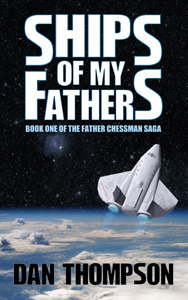 Michael was orphaned at seventeen, light-years from home. His inheritance: a starship, distant relatives he never knew existed, and inescapable questions that challenge everything he thought was true.
Michael was orphaned at seventeen, light-years from home. His inheritance: a starship, distant relatives he never knew existed, and inescapable questions that challenge everything he thought was true.
Michael’s quest for answers takes him halfway across the Confederacy, from the gleaming corridors of the wealthy super-freighters to the dark holds of Father Chessman’s pirate ships.
The truth is waiting for him, but he’ll have to survive to find it.
Where did this come from?
This story traces its origins to two main ideas. First, my father died of cancer about eight years ago. No, he did not leave behind any great mysteries, but I started to wonder what it would have been like if he had. What if he had not actually been an electrical engineer? What if he had secretly been a Cold War spy instead? Or what if he were a member of some ancient secret society? What if his old friends and enemies came looking for me?
We think we know our parents, but what if they really did have some dark secret? They could probably be quite effective at hiding it from you. You might not trust them to take you ice skating or to deliver on your Christmas wishes, but you figure that you can trust them on some fundamental issues, like what your name is, or whether they’re war criminals. Because of that, you never think to dig into those kinds of secrets. But sooner or later, the past catches up to everyone, and those secrets come out.
Another big source of this was someone who was a minor character in Beneath the Sky: Father Chessman. Something about him really appealed to me, and a number of other folks said they liked him as well. He’s the other half to the larger story arc in this series, as our protagonist Michael learns more of his own history, he finds himself learning more about the origins of Father Chessman.
In the end, the series is going to be about the rather big idea of moral equivalence, whether terrible acts are justifiable in dire situations or if some acts truly are beyond the pale. If so, which ones? What if it was your father who did it? What if it was you?
But along the way, there will plenty of space opera fun, with merchants, pirates, conspiracies, young love, and even the occasional explosion. Check out the sample chapters.
April 29, 2013
Space Elevator Misconception
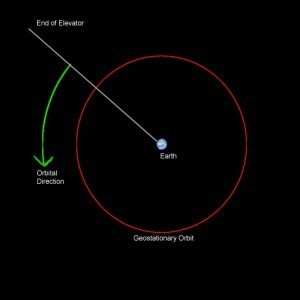 You’ve heard of space elevators, right? You know, it’s that cable that hangs down to Earth from geostationary orbit and stretches out another 35,786 kilometers past that to balance it all out. Down here on Earth, we’re experiencing one Earth gravity, 9.8 m/s2, aka “1 g”. And up at the center, in geostationary orbit, we’re weightless. And at the far end, we’re experiencing full Earth gravity again, only pointed outwards due to centripetal force, right?
You’ve heard of space elevators, right? You know, it’s that cable that hangs down to Earth from geostationary orbit and stretches out another 35,786 kilometers past that to balance it all out. Down here on Earth, we’re experiencing one Earth gravity, 9.8 m/s2, aka “1 g”. And up at the center, in geostationary orbit, we’re weightless. And at the far end, we’re experiencing full Earth gravity again, only pointed outwards due to centripetal force, right?
Wrong.
I’ve seen this crop up in a few SF stories involving space elevators, and it seems so natural that I assumed they were correct. It makes sense, after all. The bottom is being pulled down at one Earth gravity. To balance out, the other end also has to be getting pulled up at one Earth gravity. It makes sense, but it’s wrong.
Why? The key is that Earth’s gravity is stronger at the surface than in the increasingly higher orbital altitudes. Somewhere in the back of your head, you’re starting to remember something called the Inverse Square Law, aren’t you? That’s right. Like many physical phenomena, their effects decreases with the square of the distance. If you’re twice as far away, you only feel one fourth the effect.
What does that mean for our space elevator? It means that at its center, we are not balancing 1 g of gravity with 1 g of centripetal force. Rather, we’re balancing the decreased gravity from the distant Earth with an equivalent amount of centripetal force. How much gravity is there at that distance? Let’s do the math.
The formula for gravity at a distance is:
g = GM / r2
… where G is the gravitational constant, M is the mass of the body (i.e. Earth), and r is the radius of the orbit. The value of the product GM is known to high precision at 398,600.4418 km3/s2, and the geostationary orbit radius is 42,164km — 6300 of which are between the Earth’s center and surface. So at that altitude, the gravitational attraction of the earth is 0.224 m/s2, or a mere 2.28% of the gravity we experience on the surface of the Earth at the base of the space elevator.
But what does that say about the centripetal force we experience out at the far end? Well, centripetal acceleration is defined by the formula
a = w2 * r
…where w is the angular velocity in radians per second, and r is the radius of the circle we’re turning in. Since we’re still staying over the same point on earth, the angular velocity is (2 * pi) per day or roughly 0.0000729 radians per second, and our radius is about 77,950km, i.e. twice the geostationary altitude plus the radius of the Earth itself. And being swung around at that far-flung distance will net us a grand total centripetal acceleration of… 0.41 m/s2.
But we’re not quite done, because even though we’re being flung around, we’re still feeling some gravity pulling us back to the Earth. At that distance, it’s only 0.065 m/s2, but that does drop us down to 0.35 m/s2, or a mere 3.6% the surface gravity of the Earth.
You thought the Apollo astronauts looked bouncy on the Moon? They were over four and a half times heavier than they would be at the end of the elevator’s cable. It’s enough to keep things on the floor, but it’s not enough to feel very strongly.
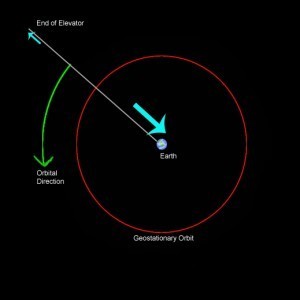 This also points out an interesting problem with balancing the elevator. After all, it’s that balance between the Earth pulling it down at the spin flinging it out that keeps it in place. But as we’ve seen, the bottom of the cable is being pulled down towards the Earth at 9.8 m/s2 while the other end is only being pulled out at a mere 0.35 m/s2. Thus, while the top and bottom halves of the cable may have the exact same mass, the bottom half is heavier. That is, it is being pulled upon with more force.
This also points out an interesting problem with balancing the elevator. After all, it’s that balance between the Earth pulling it down at the spin flinging it out that keeps it in place. But as we’ve seen, the bottom of the cable is being pulled down towards the Earth at 9.8 m/s2 while the other end is only being pulled out at a mere 0.35 m/s2. Thus, while the top and bottom halves of the cable may have the exact same mass, the bottom half is heavier. That is, it is being pulled upon with more force.
The solution to this was given when these space elevators were first proposed, and that was to put a ballast weight at the far end of the cable. If it’s massive enough, it does not even need to be at double the geostationary altitude. It could be closer to the Earth, but since it would still be above geostationary orbit, it would be pulling with all of its weight (its mass times its centripetal acceleration) outwards. Thus, you can still balance out the space elevator and keep it floating serenely in the sky.
Ahh, I hear you saying, but what if we just made the cable longer? After all, the further out the cable goes, the centripetal acceleration acting on it goes up. Maybe if we made it long enough so that the far end did experience one full g of centripetal acceleration, there would also be enough force from the mass of that longer cable to balance it out. Maybe there’s still hope for some kind of mirrored gravity at either end of the cable?
Unfortunately, no, it doesn’t work.
The root of the problem is that while gravity drops off with the square of the distance from the Earth, the centripetal acceleration builds linearly with the distance. To experience one gravity at the far end of the cable, being swung around us once per day, the cable would have to be 1.84 million kilometers long.
There are two problems with such a long cable. The first is that the orbit of the moon is only about 384,000 kilometers. While a space elevator on Mars would face a similar problem with the small moons there, it has been suggested that the moons are small enough that well-timed wave maneuvers (like plucking a taut wire) would allow the elevator there to dodge the moons. However, Earth’s moon is 156 times wider than the largest of Mars’ moons, and even if its slow-moving body could be dodged, it would be impossible to dodge its gravity which would take the math into even crazier areas.
But the bigger problem goes back to that disparity between the two forces’ relationship to radius. While the gravitational acceleration acting on the bottom of the cable drops away rapidly as it rises from Earth’s surface, the acceleration acting on the far end of the cable as we back away from the end would only decrease linearly. So, while the mass of the “top half” of the cable would be only fifty times as massive (at a minimum), the force acting on it (the mass of each part times the centripetal acceleration acting on it) would be over a thousand times as great as the force of the lower half being pulled down to the Earth.
Even if it was made from a material cable of withstanding that much force, there is no way we could secure it to the surface of the Earth. It would be plucked from its docking station like an unwanted nose hair and flung into space like… well, like an unwanted nose hair.
So keep the solar system free of nasty million-kilometer cables, and don’t insist on 1 g of centripetal acceleration at the end of your space elevators.
April 26, 2013
Review: Moon Called, by Patricia Briggs


This is the first book in the Mercy Thompson series. She’s our first person narrator and also a “skin walker”, a kind of shape-changing witch from Native American lore. Since she has the habit of turning into a coyote, she was sent to be raised by a pack of werewolves in a small Montana town. Now she’s in Washington state, living next to another werewolf, and running a one-woman garage she inherited from a gremlin.
A few of the magical beings came out to the public a few years ago, but most remain in private, including the werewolves and the vampires she’s paying protection money to. Or at least she would be paying if she could afford it. Fortunately, one of them is trying to restore an old VW bus, so she’s working it off in trade. So, she was not entirely surprised when a teenage werewolf on the run showed up at her doorstep looking for help.
As you would expect, hijinks ensue. The folks chasing the young werewolf start sniffing around for him, and the local pack of werewolves is none too happy about it. Then it starts look like an even bigger problem stemming from other packs across the country, and that brings in the pack that raised her… and by the way, she did not exactly leave that pack under the best of circumstances. Before long, the moon is up, and all hell is breaking loose. Well, not literally hell, it’s at least… um, hair-raising.
I liked it. The plot was good, and it kept me guessing. The characters were fairly real to me, and she did a good job of humanizing werewolves without turning them into sparkle-puppies. My biggest complaint was that some of the important plot-movers were “off screen” until late in the book, so I had a hard time keeping track of who was who once they showed up in the final build towards the climax. My much smaller complaint was there was a sidetrack thread about the local vampires that was interesting but not really required for the plot of this book. Clearly, it’s there to set up more events in future books, but it felt very extraneous in this one.
Still, even with those caveats, it was enjoyable. The next one is already sitting in my kindle samples, waiting to go.
April 25, 2013
Cover Reveal
Sorry for the quiet. I’ve been heads-down, finishing off the publication process of Ships of My Fathers. Here’s the cover:
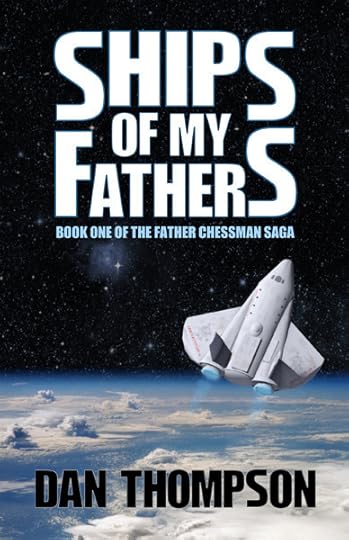
It should go on sale sometime next week.
April 19, 2013
Review: Lieutenant, by Phil Geusz
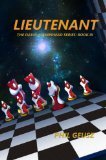

This is the third book in the David Birkenhead series. I reviewed the first two books already. It’s the story of the apparently epic career of… well, a rabbit in the royal space navy. More specifically, he’s a genetically engineered rabbit-human crossbreed, raised as a part of a slave race but elevated to the status of a free person in reward for an act of bravery.
Lieutenant picks up David’s story as he gets his first assignment following his graduation from the naval academy. Just as plenty of people tried to push him down in the academy, the defenders of the status quo intend to tuck him out of the way, never to be seen again. So, instead of the ship engineering position he desperately wanted, he is posted to graves registration, seeing to the collection and proper burial of the humans who have fallen in service to the king.
Disappointed, he does what he can to perform at his best, but he is starting to accept that he will never escape this dead-end job and will simply have to serve out the remainder of his term before trying to find his way in the civilian world. But then, as plot contrivances would have it, he finds himself out on assignment collecting bodies from an old battle that sparks back to life. Left in command by acts of foolishness and desertion by his superior officers, he has to face impossible odds, resigning himself to die in a hopeless cause.
To some extent, this is young Birkenhead facing the Kobayashi Maru challenge from Star Trek, deciding how to face death and lead his fellow officers and rabbits willingly to it, but much like James T. Kirk, he does not believe in the no-win scenario, and woe be to the enemy who expects him to lay down and die peacefully.
So, in that respect, it’s a great bit of space opera worthy of any of the better known authors and universes. But I still have to admit, it’s this rabbit thing that makes it both really weird and strangely compelling.
In many ways, Birkenhead’s status as a free rabbit acts as a placeholder for any groundbreaking career officer, perhaps the first black officer or the first female officer here in the U.S. He faces many of the same challenges that they would, from the prejudices of his fellow officers to the outright hatred of those who must defend the status quo against the inevitable pressures of the future. On top of that, he is dealing with both the admiration of his fellow rabbits as well as their own preconceptions of subservience and inadequacy.
And yet he is also dealing with many problems that are unique to being a rabbit instead of a pure human. He eats different food, so he’s not necessarily welcome in the officer’s wardroom. He’s covered in fur, and that makes a difference in some of the special engineering suits they require. And for that matter, his feet are enormous by human standards, so his dress uniform is decidedly lacking in the polished boots department. So, all of that keeps this from being a simple proxy for the standard “first minority officer” story, and that combination, as I said, keeps it both weird and compelling.
The title of the next book hints at his continued rise through the ranks, and I’m looking forward to reading it. I’d rip right through the whole series, but I’m trying to pace myself.
April 17, 2013
Final Text on Ships of My Fathers
I should have posted this a few days ago, but the weekend got crazy. I have finished integrated all the copyeditor’s fixes, and now Ships of My Fathers is at the Final Text stage. From here on out, it’s formatting, cover finalization, uploading, and so on.
I’m about a week and a half behind schedule, but there’s some slack built into the schedule. I might not hit my targeted May 1st, but it should still be out in the first week of May.
April 12, 2013
Review: Dead Witch Walking, by Kim Harrison


This is the first book in The Hollows series, an urban fantasy series where the various Inderlanders (everything from pixies to vampires) were revealed when they proved immune to a pandemic that wiped out a good chunk of humanity years ago. It’s a first person tale told by Rachel Morgan, a witch who has had her fill of working for the magical cops of Inderland Security.
So, she’s off on her own, or at least she would be if she wasn’t joined by two partners, a pixie named Jenks and her old partner Ivy, a living vampire. Being a magical private investigator is not technically illegal, but her bosses at I.S. aren’t the kind to just shake hands and say goodbye. So, in addition to setting up shop and trying to track down her first case, she’s got her old bosses trying to turn her into a grim warning to anyone else foolish enough to follow in her footsteps.
The world was interesting, and her first case was a reasonably good exploration of it. I liked the characters for the most part, though I found the vampire and pixie to be a little too stereotypical. That is, the vampire was a touch too brooding, and the pixie was annoyingly perky and excitable. The story kept things moving, but I thought it was a slow take-off with too much world-building narrative in the early chapters.
Still, it finished strong and left enough open questions to lure me into the next book. It’s evidently quite a long series now, and a friend of mine is quite happy with the later books. So, I guess I’ll be digging into them soon enough.
April 10, 2013
What do I call the series?
I am about to self-publish the first book in a five-book series. The second one is already drafted, and I have some notes on the final three. I say this to show that this is not merely a book with an open ending, but that for once I actually have a plan for how the rest of it will go.
So, I’m thinking it terms of branding the series with a common look for the covers, similarly structured titles, common font choices… everything that you expect to see in a series, and one of those things is that little splash of text on the cover beneath the title, proclaiming it to be Book One of the Impressive Series Name.
But just what do I call the series? Sometimes these are named for the protagonist like “The Dresden Files” or “The Honor Harrington Series”. Other times it’s the setting, like “The Hollows” or “Chronicles of Narnia”. And then there are enigmatic elements from the tale itself, “A Song of Fire and Ice” or “His Dark Materials”.
How do I pick one? I’m asking both for some general guidance, and I’m also going to try out a few on you and see what you think.
These books are space opera, and they deal with a 17-year-old boy growing into adulthood after the death of his adopted father. Part of the deal with that, though, is that he didn’t find out about the adoption until after that death, so there are all kinds of father-son issues going on here. The first book is titled Ships of My Fathers, and all the rest will be similarly titled, i.e. [Nouns] of My Fathers.
Common elements across all five books include the protagonist, the ship he inherited from his adopted father, and a shadowy villain who is tied up in both his past and his future. My instinct is to name it after one of those elements.
For the character, it would be: Book One of the Michael Fletcher Saga
For the ship it would be: Tales from _Sophie’s Grace_, Book One
For the villain it would be: Book One of the Father Chessman Saga
I’m not particularly married to the “Tales from…” or “Saga” aspects. It’s the other words that I’m struggling with. Naming it after the rather plain-named Michael Fletcher seems boring. I like the ship one better, though that particular ship is actually sidelined for most of the first book. And that leaves me with my current favorite, “the Father Chessman Saga” since it sounds all impressive, but I feel weird naming the series after the villain. It would be a bit like calling the Harry Potter series the Lord Voldemort series.
So… reactions? Advice? Mockery?
April 8, 2013
Standing Up
I’ve been reading articles lately quoting studies that show how sitting may be in itself bad for you. They’re showing a correlation between hours sitting and the risk of untimely death. Google will turn up many, but here is one from the Mayo Clinic.
Again, it’s correlation, not causation, but the fact that sitting is a major part of my computer-centric day means that the well-known woes of a sedentary lifestyle may be the causative link. Of note, exercising several hours a week does not seem to lessen the effects, so it really does come back to the sitting in front of the screen, whether it be computer or television.
So, what am I doing about it? Well, I’d like to say I’m not taking it sitting down, but I still mostly am. Yet today, after a few weeks of fiddling, I finally got a second computer set up in my office to use while standing.
 It’s not ideal, but I did not want to make a big investment without first seeing how well it worked out. So, I simply grabbed an extra Ikea table a friend had given me during a move. It’s essentially an 18-inch open cube, and I set it on top of my standard 30-inch high desk. The computer was one that had been effectively killed by viruses last year, but I have since revived it for this purpose. So far, my only out-of-pocket expense has been a new UPS to replace the flaky one. (Short story: Never buy the Tripp-Lite brand!)
It’s not ideal, but I did not want to make a big investment without first seeing how well it worked out. So, I simply grabbed an extra Ikea table a friend had given me during a move. It’s essentially an 18-inch open cube, and I set it on top of my standard 30-inch high desk. The computer was one that had been effectively killed by viruses last year, but I have since revived it for this purpose. So far, my only out-of-pocket expense has been a new UPS to replace the flaky one. (Short story: Never buy the Tripp-Lite brand!)
My initial impression is that it’s about an inch or two too high. I read that the ideal standing desk should be at about the level of your elbow, and at 48-inches, this setup is a touch too high for me. Also, it’s not wide enough. It certainly supports the keyboard, but it needs at least another six inches to the right for the mouse. As it is, I’m reaching forward to use a small patch to the right of the monitor.
But after letting it catch up on four months of updates, I was able to use it for about an hour. Without easy access to the mouse, it’s not appropriate for gaming or web browsing, but it is quite useable for writing text. As such, I imagine most of my testing will be done via writing. Well, it’s not like I don’t do any of that.
Certainly, an hour or two a day is not going to make much difference in my overall lifestyle and metabolism, but it should be enough for me to judge whether it’s worth making a larger investment. I don’t want to go so far as to buy a complete standing desk (or a half-and-half desk), but I figure I could get a different table to stack instead of this Ikea one. Say, 16.5” tall, 18” deep, and about 28” wide. I might not find something on the market, but I know enough woodworkers that I could get something custom for not too much money.
The news of Iain Banks’ terminal cancer is hitting a little close to home for me. I’m not ready to say that I’ve written my last book. I suppose I never will be, but I’m really not ready now.
April 5, 2013
Review: Code of the Lifemaker, by James Hogan

 This is an odd book. It starts with a long prologue that gives the evolutionary history of a machine race on Saturn’s moon Titan, from its inception with a damaged Von Neumann factory ship to mutation, sexual reproduction, competition, and the rise of diverse species and intelligence. Then it sets up a first contact situation between humanity and these machines. We in our spaceships, and they struggling to move past their own equivalent of the stone age.
This is an odd book. It starts with a long prologue that gives the evolutionary history of a machine race on Saturn’s moon Titan, from its inception with a damaged Von Neumann factory ship to mutation, sexual reproduction, competition, and the rise of diverse species and intelligence. Then it sets up a first contact situation between humanity and these machines. We in our spaceships, and they struggling to move past their own equivalent of the stone age.
There are also twin battles going on between science and mysticism. For the robots of Titan, there is a nascent movement towards science and observations, all the while struggling beneath an oppressive religious doctrine handed down in the sacred scribings of the Lifemaker. Meanwhile, amongst the humans, we have hardened scientists trying to expose the trickery of a new-age psychic who is in truth an incredibly talented con artist.
It was an interesting story, and I eventually enjoyed most of the characters, though the psychic bugged the hell out of me at first. I did find some of the storytelling mechanics hard to follow as we jumped from one setting to another and one POV to another with little visual or textual clue that it was happening. I wonder if this might have been the fault of the transfer to ebook, since this is an older book that came out on paper back in the 80’s. Either that, or it was just the way it was written.
It was a good ending in that everyone got what they deserved, so I came away pretty happy.



